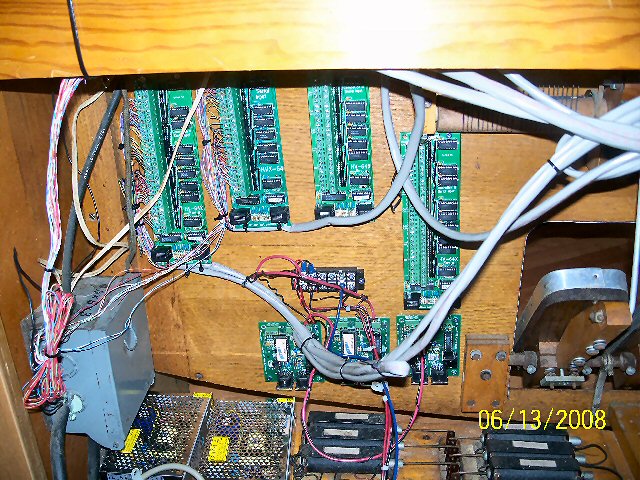DOCUMENTATION OF ORGAN RETROFIT PROJECT THIS DISCARDED 2-MANUAL MOLLER PIPE ORGAN CONSOLE HAD BEEN REMOVED FROM A LOUISIANA CHURCH, AND WAS HEADED FOR THE DUMPSTER WHEN ROBB ARCEMENT AND JOHN DEMAJO RESCUED IT. AS A SATURDAY AFTERNOON HOBBY PROJECT, THE TWO MEN RETROFITTED IT WITH AN ARTISAN INSTRUMENTS. INC. "UMIDI" RELAY SYSTEM AND MIDITZER VIRTUAL ORGAN SOFTWARE, RUNNING ON A STANDARD PC, TO YIELD A DIGITAL RESIDENCE ORGAN THAT LITERALLY "ROCKS THE HOUSE". |
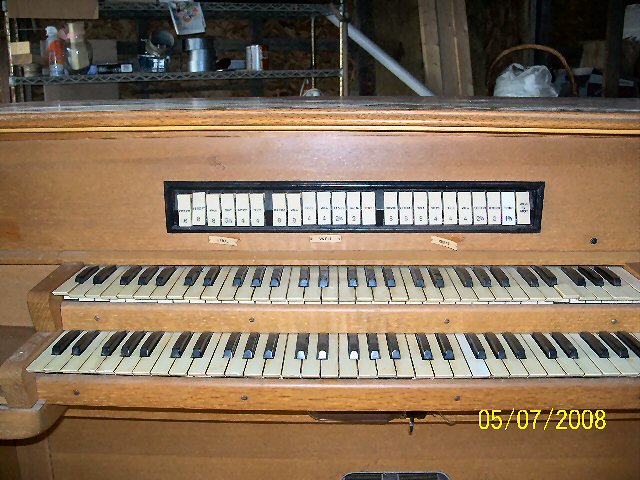 |
This 2 manual console, which formerly operated
a pipe organ in a Baton Rouge, Louisiana Catholic Church, is being
retrofitted to work as a "virtual" pipe organ. The project,
under the direction of engineer and computer specialist John DeMajo of
Hammond, LA., uses a dual-core Pentium computer system running Jim Henry's
MidiTzer software
for sound generation. Loadable sound samples are provided by the
Bruce Miles theatre sound fonts available for download on the Web.
The electro-mechanical organ console has been retrofitted with an Artisan
UMIDI relay control system, which provides the midi conversion to operate
both the computer generated sounds, as well as pipe drivers for a three-rank
Wicks pipe organ chest and ranks from the owner's previous home organ
installation. Although the project is still a work-in-progress, the organ
is now playable. To date, the entire project
has cost the owner less than one thousand dollars total, and the sound
rivals or exceeds most commercially manufactured digital organs on the
market today. According to DeMajo, this technology will give the three
big digital organ manufacturers a run for their money, and it serves to
place high-quality digital organ technology into the hands of the average
home organ enthusiast. |
Here, the back of the console, which contained
the original switching and couplers, is stripped and the new relay backboard
is installed. Installed on the backboard are the console and relay power
supplies, the three manual, pedal and stop switch input board and the
UMIDI processor modules. The next stage will be to install the stop magnet
modules so that the organ's combination action will again operate. New drawknob and tablet stops which will now be controlled by
an Artisan Mag driver board, are being added. All console components, including the personal
computer motherboard, are mounted in the back of the console. A single
ethernet cable will connect the console to the pipe chamber containing
the three-rank Wicks chest and pipes. According to DeMajo, the Artisan
company, which has a long history in the manufacture of quality organs
and organ control systems for church and commercial use, has realized
the value that their UMIDI system offers to home organ hobbyists, and
the company has now begun actively supporting owners who wish to build
their own instruments. |
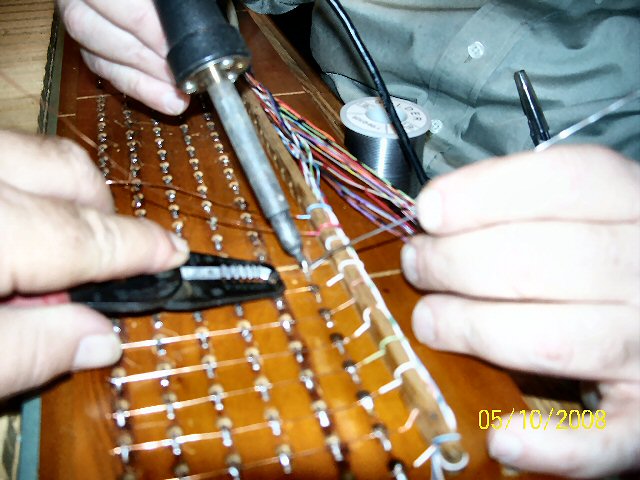 |
As part of the process, the original Moller key contacts were reconditioned and all cotton insulated wiring was removed and replaced with TELCO grade thermoplastic wire. Since all switching, unification and rank splitting is done in the Artisan software, it is not necessary to have multiple contact switches and wiring for each manual and pedal key. Only 61 individual key wires are required per manual. In the photo above, contacts that originally keyed the 16, 8 and 4' registers are now all wired together to provide one input point per key. This means that each note has back-up contacts in the event that any one contact fails. In the case of the Swell manual above, there are now five contacts in tandem for each note, so there will be no problem should one contact become less than stable in the future. |
The original wiring changes, and method of
connection to the midi system are noted above. |
Pictorial of the organ control system. To
see an enlarged copy of this, click on the drawing above. According to
DeMajo, the Artisan control system is the key to the simplicity of the
instrument. Any average computer tinkerer can now build his or her own
high-quality digital organ for less than the cost of a good portable electric
keyboard. |
The entire sound producing equipment for the organ is based on this standard desktop personal computer motherboard. The computer's sound card acts as a synthesizer for reproduction of the digital sound samples from the software. |
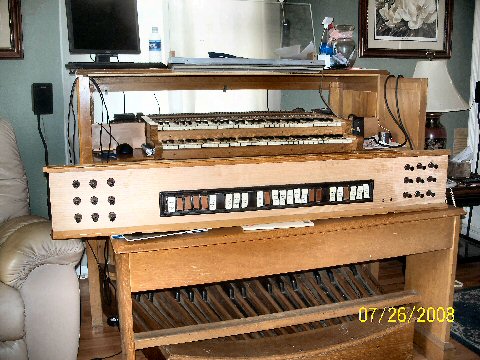 |
Since the original console was designed around a Moller Artiste, it was necessary to add stops so that we could adequately make use of the Miditzer software's resources. Since Robb likes to play classical organ too, we decided to make use of some inexpensively obtained draw-knob type stops that became available. Here you see the new stop board which was built by Rive Pipe Organ Co., of Metairie, LA. to replace the original limited stop switch selection. The switches and draw knobs will be connected to the Artisan Mag board so that the organ will now have a multi-level combination action and memory. |
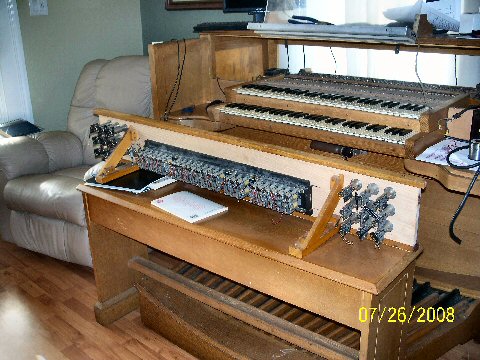 |
Rear view of the stop switches before being wired and installed into the console. |
 |
PROJECT DESIGNER JOHN AT THE PARTIALLY COMPLETE CONSOLE. |
| We have brought the project to the point where the manuals and the pedals are playable. Next, we will install the combination action and stop controls. PLEASE CHECK BACK IN THE COMING WEEKS TO SEE HOW THE PROJECT PROGRESSES |
(Background music, "Body and Soul"
played on the organ shown in the pictures above by John DeMajo ) |
